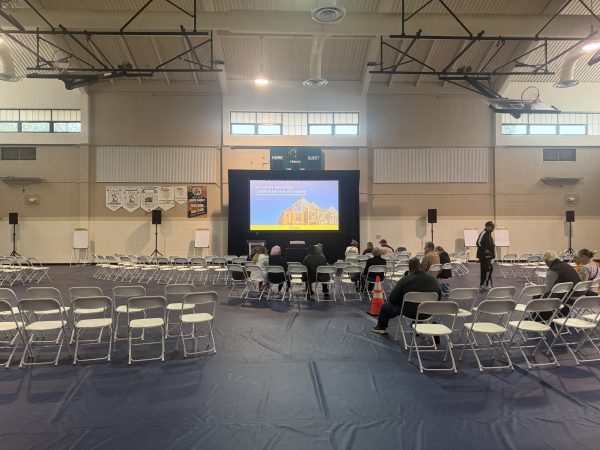What first-time voters should know about the process
Poll workers were prepared to assist voters through the new electronic voting systems in the Palmer Wing of the Library at Cal State L.A.
With all the demands of life and work, voting may not be everyone’s priority. That’s especially true for those who haven’t voted before because they have to invest extra time learning how to do it.
“For a first-time voter and people that want to get involved, you just don’t know how to do things. You go online and you try to google things and the first thing you see are so many ads. You don’t know where to start,” said Sim Bilal, a South L.A. resident and youth climate activist.
And yet, measures on the ballot and the elected officials chosen have impacted the lives of people throughout the county and state. It’s often those who are most impacted by changes in policies on issues such as housing, healthcare, and climate change who have the least time to be informed about them and to hit the polls.
That’s why UT Community News is breaking the process for first-time voters down into three main steps.
Register to vote
To register to vote, you must fill out a voter registration application on your local county website. Los Angeles County voters can go to LAvote.gov for this.
You’ll need to provide, among other things, your legal name, identification, address where you reside, whether you would like to vote by mail, and political party preference.
The voter registration deadline is usually about two weeks before the election. For the Nov. 8 election, it is Oct. 24.
Your registration form will ask you if you would like to vote by mail or in a polling place. You can pre-register to vote at 16 or 17 years old and automatically be registered to vote when you turn 18 years old.

Learn what’s on the ballot
While doing research for a ballot measure, find out what each candidate has done and what they support; what the various measures proposed would do; who proposed them and who is for and against them; and who benefits. Use credible information sources such as a trusted news source and your local city or county website, such as LAvote.gov.
“When going through ballot measures, talk to others to shape your opinion and others,” said Brennie Dale, an alumna of Human Rights Watch’s student task force. “Voting is not easy, who funds the [ballot measures], who benefits? Don’t be intimidated by older voters and politicians.”
The state also provides an official voter information guide listing your rights as a voter; candidates’ statements; and information about statewide propositions, including a summary of each, the pros and cons, and what voting “yes” or “no” means; candidates’ statements.
Information on who is contributing the most money for and against various measures and candidates can be found on the Secretary of State’s campaign fundraising reporting website.
Vote by mail or find your polling place
If you planned to vote by mail in the upcoming November election, a ballot would have been sent to your home before or on Oct. 8.
You have a few options for returning the ballot.
- You can mail it back and it must be postmarked on or before the election day, Nov. 8, and received by your county elections office no later than seven days after election day.
- You can drop it off in one of the county’s ballot boxes, which are available 29 days before the election and on election day, until 8 p.m.
- You can authorize someone to return the ballot for you as long as they don’t get paid on a per-ballot basis. For your vote to count if you choose this path, you must sign the authorization section on the ballot.
- You can drop it off at a polling place between 7 a.m. to 8 p.m. on Election Day.
A list of polling places will be available 30-40 days before election day, according to the county. Polling places will be open from 7:00 a.m. to 8:00 p.m. on Election Day Nov. 8.
If you vote by mail, you can track the status of your ballot by signing up on the California Secretary of State’s “Where’s My Ballot?” webpage. Once you sign up, you’ll get emails, texts, or voicemails saying:
- The date that the ballot is expected to be delivered to the voter
- When the ballot has been delivered
- If the voter’s ballot is returned as undeliverable to county elections official by the USPS
- Whether the voter’s completed ballot has been accepted when the completed ballot is received by the county or a reason why the ballot could not be accepted and instructions of steps the voter can take in order to have the ballot accepted
- The deadline for the voter to return the ballot if the county has not received a voter’s completed ballot by specified dates
Bilal encouraged first-time voters to start early on understanding the process and reading up on candidates and issues, and most importantly, to ensure they make it to the polls or the ballot box.
“The history of voting is very racist,” he said. There are things in our community that prevent us from voting in the first place and it does not make sense nowadays [for] communities to not go out to vote when they have been notoriously blocked from it.”
Resources for California voters
Register to vote: https://www.lavote.gov/home/voting-elections/voter-education/what-to-do-before-an-election/register-to-vote
Sign up to vote by mail: https://www.lavote.gov/home/voting-elections/voter-education/what-happens-to-my-ballot/when-i-vote-by-mail
Read answers to frequently asked questions: https://www.sos.ca.gov/elections/frequently-asked-questions
See where your ballot goes in a flow chart: https://www.lavote.gov/docs/rrcc/election-info/vbm-ballot-lifecycle-flow-chart.pdf
This story was cross-published on KCET and PBS SoCal.
Community News produces stories about under-covered neighborhoods and small cities on the Eastside and South Los Angeles. Please email feedback, corrections and story tips to UTCommunityNews@gmail.com.

Leslie Magaña Arias is a reporter for the UT and Editor in Chief of the UT Community Magazine. She is a vegan and a human rights activist who enjoys doing...









